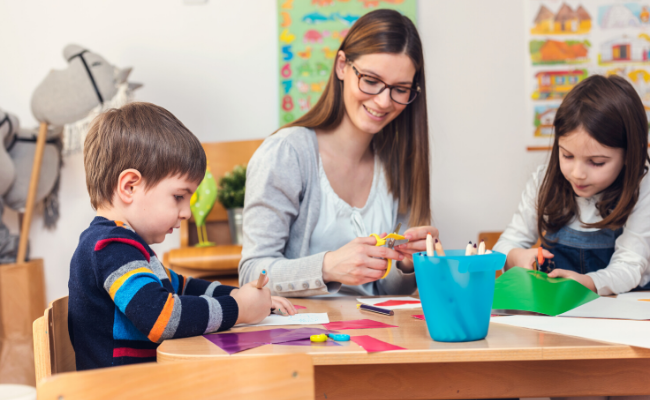In light of new research and emphasis on Least Restrictive Environment (LRE), a lot of SPED departments are wanting to move towards a push-in model of services for speech and language, particularly for preschool students. This is how I provide push-in services to my Preschool students in Special Day Classes and how it can be adapted to fit general ed preschools as well.
CENTERS:
Many preschool classrooms have a designated time to hold different activity centers. In the classrooms I’ve worked in, each center typically lasts 15 minutes long (perfect for 15 minute sessions!). Depending on the size of the class, each group can range from 1 student to 6 students; 4 students is a good group size. The groups spend 15 minutes at a station. When an audible timer goes off for the whole class, each group rotates to the next center. This is where many preschool programs may implement a “visual schedule” to help students transition to the next activity successfully. How the visual schedule looks varies with teachers, some have the teacher/para at each center give the student a picture to match that corresponds with the next table, and some teachers provide an individual schedule to each child.
WHOLE CLASS INSTRUCTION:
This is where I take an opportunity to give teachers and paras a (well-deserved) break and/or provide modeling of good speech/language instruction practices. I like to use the themes that the classroom has, or follow my own calendar of themes. Lessons usually involve a song, manipulatives and/or visuals, turn taking, and practice in generating sentences. These lessons usually last 15 minutes. (So between a 15 minute center-based session and 15 minute whole class lesson, this usually takes care of the common 30 minutes weekly)
ANATOMY OF A SESSION:
This is probably the most important part of making your sessions successful. Involve multi-modal learning techniques- song, spoken modeling, pacing boards, visuals, hand motions.
Schedule/structure:
1) Introductions-important especially for ASD and SDC classes.
2) Story/Song/Video that is directly related to the lesson.
3) Interactive activity-eliciting responses: this is where data collection comes in.
4) Cue to end activity, begin preparing for transition- WBL cue, give stickers or farewells, give visual schedule cue.
DATA COLLECTION:
If you’re lucky, working in a session with 1-2 students is great for collecting data. I keep my therapy log (that includes a 20 frame) in front of me as I’m working so I can track responses (+/-). If you’re like most SLPs, you don’t have that luxury! Instead, for larger groups of 3-6 students, I make therapy session data sheets that have the center group students listed on the left, shorthand for their goals in the next column, then take data in the right column.
I hope you find these strategies helpful in your new service delivery method!
Author: Caroline Donham, M.A. CCC-SLP

